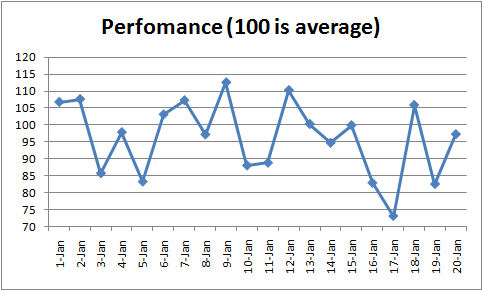The Employee Reprimand: Is It Effective?
Generally, on the spot reprimands and ‘attaboys’ reinforce the wrong behavior…by leaders.

Is a general employee reprimand effective?
Consider this. A leader is in charge of an average performer who has a bad day and really botches something up. The leader pulls the laggard off to the side, and gives him a stern ‘taking to’. The next day, performance is improved.
On the flipside, the same average person may pull a rabbit out of a hat. The leader is impressed, and tells the team member so. Unfortunately, performance soon fizzles.
A leader will see the reprimand as being effective and the pat on the back as not working very well.
Look around. In practice, this tends to hold true. Leaders are far more likely to use an employee reprimand than positive reinforcement.
But let’s look at the statistics behind this.
In the first case, the reprimand, performance is below the mean. Without the boss saying a single word, the individual is likely to do better the next time around. When the boss lays down the law, it is impossible to tell what effect it has on the person, since performance would be likely to improve anyway.
Now let’s look at the reverse. The positive reinforcement won’t change a person’s chance to outperform his skills. So leaders see slippage after telling an employee about his wonderful work. And when they see something that doesn’t work, they stop doing it.

Employee Performance Run Chart
I used Excel’s random number generator to make this chart. I indexed it with 100 as a person’s average performance. I put in a normal distribution with a standard deviation of 10.
Without any feedback, you will notice that high performance (over 105) was almost always (5 of 6 times) randomly followed by lower performance. Poor performance (under 90) went up 5 out of 7 times, purely by random chance.
In truth, there is a cause and effect relationship, but it is not what most people think. Poor performance causes the reprimand; good performance inspires a leader to give kudos.
But the general feedback, at least in the short term, might not have as much effect on future performance as it appears. It would be like screaming at worms to come out of their holes whenever it starts raining, and then thinking that the yelling was effective.
Let’s try this experiment.
Get some glitter and put it in an envelope labeled “Magic Dust”. Whenever an employee has poor performance, sprinkle some on their toes, and see how they do in subsequent projects. Purely by chance, most will improve.
Don’t believe this happens? It actually was studied many years ago in the Israeli Air Force to see what effect feedback (aka abusive yelling) from instructors had on pilot training. (The magic dust part wasn’t studied, just the reprimand part.)
So what can a Lean leader take from this truth about leadership and human behavior?
They can use a more sophisticated approach than ‘Good Job-Bad Job’. This means paying attention to the specific causes of poor performance, and watching for trends. More importantly, it means providing employees with the right tools and training to be effective in their jobs to minimize the randomness of performance.
It also means the boss must realize that Leadership takes long-term commitment to refine skills, adjust behaviors, and develop an engaged, satisfied workforce. Actually influencing employee performance is not an easy, overnight task.
I’d love to hear your thoughts on this. What do you do to help an employee improve his or her performance after having a bad day?



1 Comment
gwhite · August 23, 2012 at 11:00 am
It has been my experience that Leaders (true leaders) versus Managers tend to focus on the people who are in their charge and personnel performance and attitude reflect the expectation of that Leader. People will rise to the expectation of their Leadership whether it is high, marginal or low. There are outliers of course, but in the main when people are developed and valued, their opinions heard and appreciated there are fewer opportunities for the one-off pats on the head and conversly the occassional reprimand. Instead there is a collaborative effort environment where the whole team accomplishes more than the sum of its individual’s contributions. Yes, egos can play a factor but here again is where the leadership’s paradigm comes into play on what behavior is and is not deemed acceptable. Case in point, early in my career there was an executive that was quick to criticize and slow to praise. I would actually cringe when I would receive a pat on the back because I knew that I would get crucified and be marginalized within the next 5-7 days over something we both would deem to be insignificant. I have also worked for Leaders who were more mentors than managers and as a result, I learned more, became a larger contributor to the company and my performance and productivitiy shot through the roof. So, all in all, I have to say I agree with the article and feel strongly that 1. Investment in people is the most powerful investment of an organization and 2. “attitude reflects leadership” (Remember the Titans, 2000).